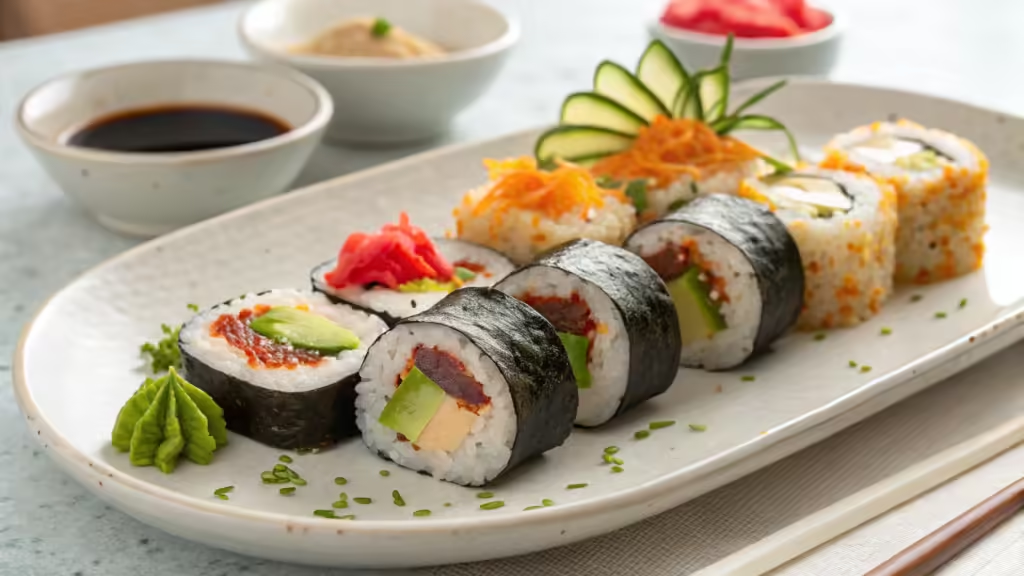What are good sushi fillings? This question is essential for anyone looking to create flavorful and well-balanced sushi rolls. A good sushi filling strikes the perfect balance between freshness, texture, and flavor. When choosing what are good sushi fillings, it’s important to consider ingredients that complement each other while enhancing the overall sushi experience. The right sushi fillings add character to each roll, creating a delightful combination of taste and texture. Whether you enjoy traditional sushi fillings or prefer modern variations, selecting high-quality ingredients can elevate your sushi-making skills.
Popular sushi fillings have long been inspired by traditional Japanese cuisine, but in recent years, creative twists and fusion flavors have broadened the possibilities. If you’re wondering what are good sushi fillings, the best place to start is with classic ingredients such as tuna (maguro), salmon (sake), and pickled vegetables. These foundational sushi fillings are widely loved and provide a reliable starting point for both beginners and experienced sushi makers.
For those who want to take their sushi-making skills to the next level, understanding what are good sushi fillings is key. Experimenting with different combinations allows you to discover unique flavors that match your taste preferences. While classic sushi fillings like shrimp, crab, and avocado remain popular, modern sushi rolls often incorporate ingredients like spicy tuna, tempura shrimp, and even fruits like mango for a sweet contrast. If you’re asking yourself, what are good sushi fillings beyond traditional options, the answer lies in your creativity and willingness to try new ingredients.
Exploring Popular Sushi Fillings – What Are Good Sushi Fillings?
1. Classic Sushi Fillings
These timeless options have stood the test of time due to their simplicity and taste:
- Tuna (maguro) – A sushi staple prized for its rich, buttery flavor.
- Salmon (sake) – Known for its delicate taste and silky texture.
- Shrimp (ebi) – Both cooked and raw options offer versatility.
- Cucumber (kappa) – Adds crunch and freshness.
- Avocado – A creamy, modern favorite.
Traditional fillings like these form the backbone of sushi rolls worldwide.
2. Vegetarian and Vegan Options
Sushi is not just for seafood lovers! These plant-based fillings are equally delightful:
- Pickled radish (takuan): Sweet, tangy, and crunchy.
- Sweet potato tempura: Crispy on the outside, soft inside.
- Carrots and cucumbers: Simple yet refreshing.
- Avocado with cream cheese: A luxurious blend of creaminess.
For more ideas, Healthy Sushi Guide offers a comprehensive list of nutritious fillings that cater to every palate.
Innovative and Unique Fillings
For adventurous foodies, modern sushi fillings bring bold flavors and creative pairings:
- Spicy tuna with sriracha mayo for a fiery kick.
- Mango and cucumber with chili flakes for a sweet-spicy twist.
- Tempura shrimp topped with eel sauce for an irresistible crunch.
- Teriyaki chicken or beef for a fusion experience.
- Smoked salmon paired with cream cheese.
Sushi Toppings and Pairings
To complement your sushi, toppings and side dishes enhance both presentation and taste.
Common Toppings
- Roe (ikura or tobiko): Adds salty bursts of flavor.
- Sesame seeds: Nutty and aromatic.
- Green onions: A fresh and zesty garnish.
- Wasabi and pickled ginger: Staples for balance and cleansing the palate.
Perfect Pairings
Pair your sushi with:
- Soy sauce, including low-sodium or flavored varieties.
- Miso soup and edamame for a complete meal.
How to Roll Sushi Like a Pro?
Mastering the art of rolling sushi is essential to showcase your perfect fillings. Follow these tips to create restaurant-quality rolls:
- Prepare Your Rice Properly: Use sushi-grade rice seasoned with rice vinegar, sugar, and salt. Spread it evenly on the nori sheet without overpacking.
- Layer Fillings Strategically: Place the heaviest ingredients, like fish or tempura, closest to the center, and lighter ones, like cucumber or avocado, toward the edges for balance.
- Use the Right Tools: A bamboo sushi mat (makisu) ensures tight and even rolls. Wrap the mat in plastic wrap to prevent sticking.
- Roll with Confidence: Start by gently folding the edge of the nori over the fillings, then roll tightly while pressing evenly with the mat.
- Seal the Roll: Use a bit of water to seal the edge of the nori, ensuring it stays intact when slicing.
With these techniques, you’ll create neatly rolled sushi that highlights your fresh, vibrant fillings. Practice makes perfect, so don’t hesitate to experiment and refine your skills!
FAQs About Sushi Fillings – What Are Good Sushi Fillings?
1. What are the most popular sushi fillings worldwide?
The most popular sushi fillings vary by region but often include:
- Tuna (maguro) – Known for its rich, savory flavor.
- Salmon (sake) – A favorite for its buttery texture.
- Crab (kani) – Frequently used in California rolls.
- Avocado – A creamy, modern addition loved globally.
- Cucumber – Adds crunch and freshness to any roll.
2. What fillings are best for vegetarian sushi?
Vegetarian sushi can be just as delicious as traditional options. Try these:
- Pickled radish (takuan) – Sweet and tangy with a satisfying crunch.
- Sweet potato tempura – Crispy on the outside, soft inside.
- Carrots and cucumbers – Classic, fresh, and easy to prepare.
- Avocado and cream cheese – A luxurious and creamy combination.
3. Can I use cooked ingredients for sushi fillings?
Yes! Using cooked ingredients is perfect for beginners or those who prefer not to eat raw fish. Popular cooked options include:
- Shrimp tempura – Crispy and flavorful.
- Grilled eel (unagi) – Sweet and smoky.
- Teriyaki chicken or beef – Adds a fusion twist.
- Cooked crab or imitation crab (kani kama) – A common filling in many rolls.
4. How do I make sushi rolls without seaweed?
If you’re not a fan of seaweed (nori), you can still enjoy sushi rolls:
- Use soy paper for a lighter, milder alternative.
- Wrap sushi in thinly sliced cucumber or rice paper.
- Opt for inside-out rolls where the rice is on the outside, hiding the nori.
5. What are the healthiest sushi fillings?
For a nutritious sushi experience, consider these healthy fillings:
- Fresh vegetables like cucumber, avocado, and bell peppers.
- Lean fish such as tuna or yellowtail.
- Brown rice instead of white rice for added fiber.
- Fruits like mango for natural sweetness.
6. What is the easiest sushi filling for beginners?
Beginners should start with simple and forgiving fillings such as:
- Cooked shrimp or crab.
- Cream cheese and cucumber for a mild, creamy option.
- Avocado for its smooth texture and versatility.
7. Can sushi fillings be customized for dietary restrictions?
Absolutely! Sushi is incredibly versatile and can cater to various diets:
- Use gluten-free soy sauce for those with gluten sensitivity.
- Replace seafood with more vegetables or tofu for vegan options.
- Include lean proteins and low-sodium ingredients for health-conscious individuals.
Conclusion – What Are Good Sushi Fillings?
Sushi fillings are a gateway to exploring a world of flavors, textures, and creativity. Whether you prefer classic tuna and salmon rolls or are drawn to innovative options like sweet breakfast sushi rolls, the possibilities are endless.
If you’re inspired to experiment with your own recipes, why not explore this guide to fresh start creamy avocado and smoked salmon breakfast sushi for a unique take on morning sushi? You might also enjoy learning how to make a sushi burrito with diverse fillings that merge tradition with modern flair by checking out this recipe.
Dive into your culinary creativity and turn your kitchen into a sushi bar where every roll tells a story. If you’re looking for a broader range of ideas, explore these easy recipes for even more delicious inspiration.
Sushi-making is more than food preparation—it’s a journey of taste, art, and exploration. So, grab your bamboo mat and start creating!




